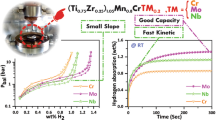Abstract
The optimal compositions are selected and amorphous alloys based on various metals (nickel, magnesium, rare-earth elements, iron, chromium, zirconium, titanium, etc.) are developed in the form of rapid-quenched tape having amorphous, nano-, and microcrystalline structures. The obtained intermetallic compounds with various compositions might be used for hydrogen storage. The accumulation of hydrogen by Zr-based amorphous samples is established to be 1.8 times higher than the capacity of the same but crystalline sample. The crystalline samples belonging to the Mg-Ni system are found to accumulate up to 3.2 wt % hydrogen upon hydrogenation and to release a three times larger amount of hydrogen than zirconium-based alloys upon dehydrogenation. The accumulating hydrogen capacity in this case, \(\Delta C_{H_2 } = C_{H_2 }\) (sorption) — \(C_{H_2 }\)|(desorption), is significantly higher for the Mg-Ni samples than for the zirconium-based samples.
Similar content being viewed by others
References
Sakintuna, B., Lamari-Darkrim, F., and Hirscher, M., Metal Hydride Materials for Solid Hydrogen Storage: A Review, Int. J. Hydrogen Energy, 2007, vol. 32, no. 9, pp. 1121–1140.
Kolachev, B.A., Shalin, R.E., and Il’in, A.A., Splavy—nakopiteli vodoroda: Spravochnik (Hydrogen-Accumulating Alloys: A Handbook), Moscow: Metallurgiya, 1995.
Hydrogen, Full Cells and Infrastructure Technologies Program. Multi-Year Research, Development and Demonstration Plan for 2003–2010, US Department of Energy, 2003.
Konstanchuk, I.G., Ivanov, E.Yu., and Boldyrev, V.V., Interaction of Melts and Intermetallides Produced by Mechanical Methods with Hydrogen, Usp. Khim., 1998, vol. 67, no. 1, pp. 75–86.
Klyamkin, S.N., Lukashev, R.V., Tarasov, B.P., Borisov, D.N., Fokin, V.N., and Yartys’, V.A., Hydrogen-Sorbing Magnium-Based Composites, Materialovedenie, 2005, no. 9, pp. 53–56.
Diagrammy sostoyaniya dvoinykh metallicheskikh sistem. Spravochnik (Phase Diagrams of Binary Metal Systems: A Handbook), Lyakishev, N.P., Ed., Moscow: Mashinostroenie, 1993, vol. 3, p. 145.
Amorfnye metallicheskie splavy (Amorphous Metal Alloys) Lyubarskiy, F.E., Ed., Moscow: Metallurgiya, 1987.
Rapidly Quenched Metals, Steeb, S. and Warlimont, H., Eds., Amsterdam, 1985; Moscow: Metallurgiya, 1989.
Burnasheva, V.V. and Tarasov, B.P., Effect of Partial Change of Nickel or Yttrium by Other Metals on Adsorption of Hydrogen by YNi3 Compound, Zh. Neorg. Khim., 1984, vol. 29, no. 5, pp. 1136–1141.
Author information
Authors and Affiliations
Corresponding author
Additional information
Original Russian Text © M.A. Burlakova, V.G. Baranov, I.I. Chernov, B.A. Kalin, A.V. Svetlov, 2011, published in Perspektivnye Materialy, 2011, No. 1, pp. 23–28.
Rights and permissions
About this article
Cite this article
Burlakova, M.A., Baranov, V.G., Chernov, I.I. et al. Amorphous and crystalline alloys for reversible hydrogen storage. Inorg. Mater. Appl. Res. 2, 452–456 (2011). https://doi.org/10.1134/S2075113311050091
Received:
Published:
Issue Date:
DOI: https://doi.org/10.1134/S2075113311050091



